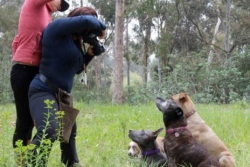Put these tips into practice and you’ll soon move away from dark, blurry, “meh” snapshots to taking vibrant, personality-filled and even artistic pictures of the dog you love most. Ready? Here we go!
1) Plan ahead. Many times you’ll serendipitously stumble upon cool places; that’s great. But your best shots will come when you plan. The place. The time of day. The number of distractions that will compete for your dog’s attention in your setting of choice. The collar your dog wears for the photos. Be a planner. It’ll make all the difference in the world.
2) Shake out “the sillies” ahead of time. Take 10 minutes to have your dog shake out his sillies before you even bring out the camera. He’ll cooperate more after he’s had a chance to ‘just be.’ Let him potty. Let him sniff around. He’ll be more physically relaxed after he’s released some energy. Just be careful not to overdo it because too much panting and slobber makes for less than ideal photos. Also see suggestion #8 about choosing the most ideal weather and time of day to bring out the best in your dog’s expression and body language.
3) Treats. Don’t (you dare!) leave home without them. And by treats, we’re not talking about the boring kibble that your dog eats every day. Bring out the stuff that your dog only dreams about. After a few sessions of photos, your dog should love the sound of the camera shutter and the site of the camera because it will come to mean super high value treats.
Now then, if you’re working the camera, how are you going to “bait” your dog’s attention with the treat? That’s where your “help” comes in. See below.
4) Have a person – let’s call that person your “attention-getter” – bait your dog’s attention toward you. Ask your attention-getter to stand 6 inches behind you, drawing the dog’s attention to your camera with say, string cheese, a favorite squeaky toy — whatever is both interesting and highly interesting to your dog. Have your attention getter keep your dog’s focus on your camera by luring the dog’s attention to your camera lens — and nowhere else. You’re looking for quizzical looks. Cute head tilts. Whatever focused expressions you can get from your dog.
5) Up close and personal! Lock your camera’s focus point on your dog’s eye. The eye is the window to the soul. A sharply focused eye will communicate a great deal of your dog’s character. Isn’t that why you’re reading this?
6) Shoot tight. Then crop even tighter on your computer later if you’re the perfectionist type! The idea is to try to leave out everything that’s not important to your dog’s story — and especially to eliminate anything that distracts from your dog’s beauty.
Basically, get close. No, closer. There you go!
7) “Sit” and “stay.” Your dog doesn’t need to know a whole heap of commands to make your photography look good, but a reliable sit – and even more importantly, a reliable stay – will go a long way in helping you go from creating mere snapshots to creating art. How do you think William Wegman, of Weimaraner photo fame, created so many endearing photos? StaaaayGood dog!
8) No thanks to bright sunny days. People are often surprised when they hear professional photographers complain about bright sunny days. It’s true…they’re the worst! A nice overcast day is what you really want; some cloud cover disperses light beautifully and evenly. It doesn’t leave nasty shadows on the dog’s face. It lets you shoot from whatever direction you please.
Unfortunately, we don’t get a lot of overcast days on which to shoot. So rather than take your dog’s photos when the sun is at its zenith (which has a tendency to rob photos of deep, vibrant colors) follow this suggestion. Take advantage of “the golden hour.” This is the 90 minutes after sunrise and the 90 minutes before sunset. Shoot with the sun BEHIND your back. The results of golden hour photography can be breathtaking for the quality of the sunlight alone. But remember that your shadow will be long at this time of day, so don’t let your shadow show up in the pictures.
9) Watch your backgrounds. Chain link fences, vehicles, porta-potties, garbage cans that big yellow school bus. “Photography clutter” is all over our world. Look for backgrounds that are not busy, aren’t metallic, etc. You want earthy tones and textures behind your dog. This has the benefit of creating a soothing aura and setting.
10) Get down low. On your butt, on your belly or on your knees. You’ll be creating a much more interesting and intimate perspective by getting down there. Got bad knees? Bad back? Use knee pads, use a stool, use whatever! Exceptions notwithstanding, photos taken from a standing position, looking down on your dog can be very…well, let’s just say they can be common. Yaaaawn!
Alrighty, there you have it! Ten tips to make your dog look as great in photos as he is in your mind. The great thing about digital photography is that you can get better pretty quickly. What you consider a “good” image today will take a backseat to your better images tomorrow.
Hany Hosny shares life with his adopted shelter dog, Stella. He volunteers at animal shelters and shares his relationship-centered ideas on living with dogs, on his popular Facebook page, Smarter You, Happier Dog.

